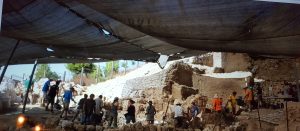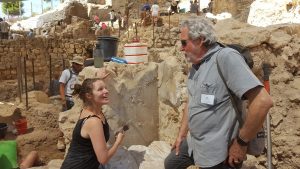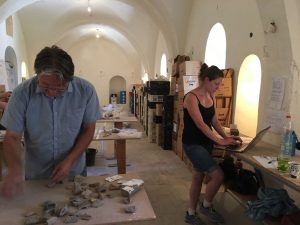
“DO YOU HEAR THAT SOUND? ALL ABOARD THE BUCKET TRAIN!”
Christy Grobmeier, 2017 Member Supported Excavation Fellowship Recipient
Sponsored by the University of North Carolina, Charlotte and led by Drs. Shimon Gibson and James Tabor, the current excavation of Mount Zion continues the work begun by Magen Broshi in the 1970s. The site which lies on the south side of Jerusalem and just outside the current Zion Gate proves one of the most fascinating and enigmatic in Israel. This year, thanks to the generous support of a donor scholarship through ASOR, I’m fortunate enough to be working directly under Dr. Shimon Gibson where I handle the recording of pottery, accounting matters, and other clerical duties after getting down and dirty in the trenches and conducting The Bucket Train – the most exciting bucket chain in the history of archaeology.

Historically, the site yields finds from the Iron Age through to the modern age. The stratigraphic information proved a little more difficult to decipher, however, as it served as a rubbish heap over different time periods and the area suffered several serious earthquakes. In addition, bulldozers and cranes used during the Broshi excavation moved modern trash under a number of levels, such as the Early Roman or Late Hellenistic. While this may seem problematic, I found an intact 1970s bicycle my first year. Despite having gotten my tetanus boosters, I was denied my newfound transportation to site.
During the Second Temple period (1st century C.E.), the city walls enclosed the area in which many priestly or wealthy families resided. Due to the fill created by the construction of the Byzantine-era Church, we discovered these uncommonly well-preserved and lavish homes featuring entire first and second storeys, mosaics, a bath tub, and a high number of costly murex shells used to dye priestly garments.

The site also holds strategic importance, most notably during the Crusades, where the Fatimids constructed a large trench to keep the invading forces at bay. The tactic worked quite well until the Crusaders chose to attack from the north, nullifying the defenses. Much later, during the 1948 Arab-Israeli War, the site served as No Man’s Land, evidenced by the barbed wire and bullet-riddled canteen found in the lovingly termed War Box.
Dr. Shimon Gibson (L) and Christy Grobmeier (R) sorting and recording finds in the Armenian Museum after digging
My day typically involves arriving to site at 5 A.M. with the other staff members, digging until 9:30 A.M., then moving to the Armenian Museum which serves as Dig Headquarters. I fill the rest of my morning and early afternoon with editing registers, recording financials, and preparing for the rest of staff to arrive at 1:30. When Dr. Gibson arrives, we work in tandem to sort and record finds which are then reconciled with the locus lists, typically around 5 P.M. or so. Some of our more notable finds are a gold coin dating back to Nero (56 C.E.), a mysterious inscribed stone vessel, and massive spiders. So many very large spiders – though I’m kind enough to let someone else get in on that “fun”.
The days are long and exhausting but so worth it. I get the best of both worlds: I play in the dirt in the mornings and not only can I examine the finds in the afternoons, I’m treated to a first-class education. As a graduate student, money is certainly a top concern of mine and I am incredibly grateful for the generosity of ASOR and the donors.
Christy Grobmeier is a recent transplant from Houston, Texas to Charlotte, North Carolina. She is a religious studies M.A. student and teaching assistant under Dr. James Tabor of the University of North Carolina. She earned her B.A. in Anthropology with dual minors in religious studies and French language from the University of Houston. Her current research interests include the archaeology of Jerusalem, early Christianity, and Aramaic incantation bowls.
